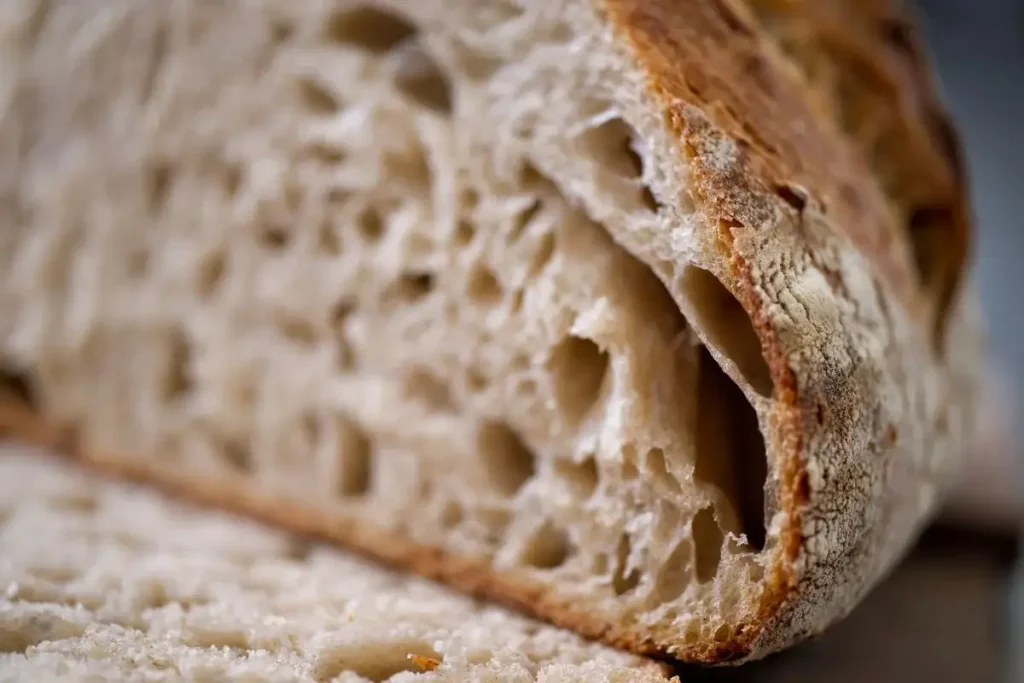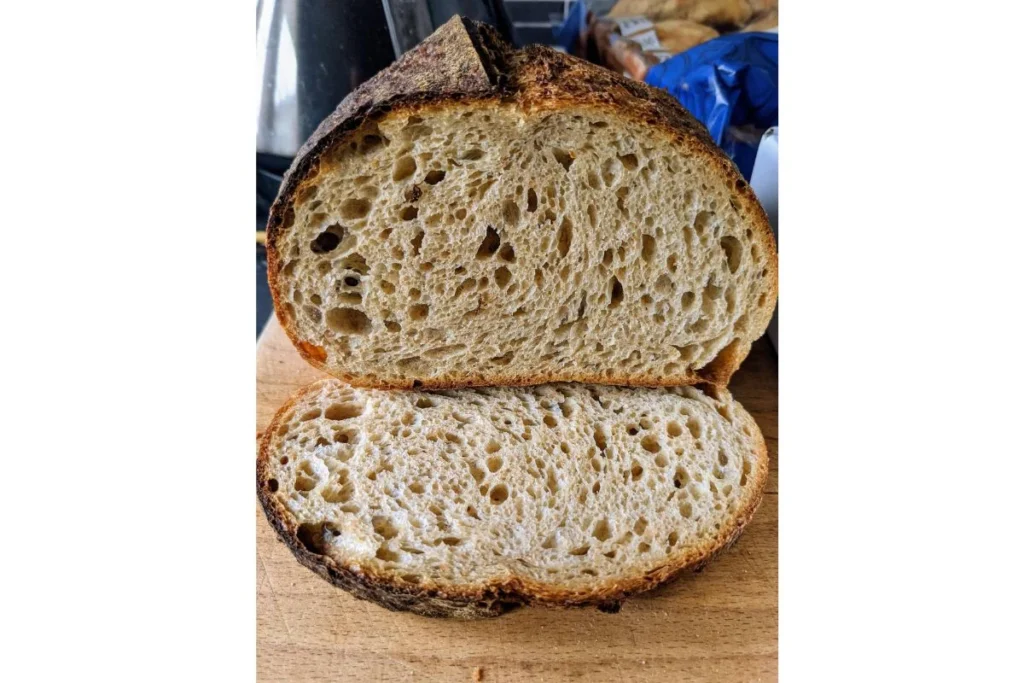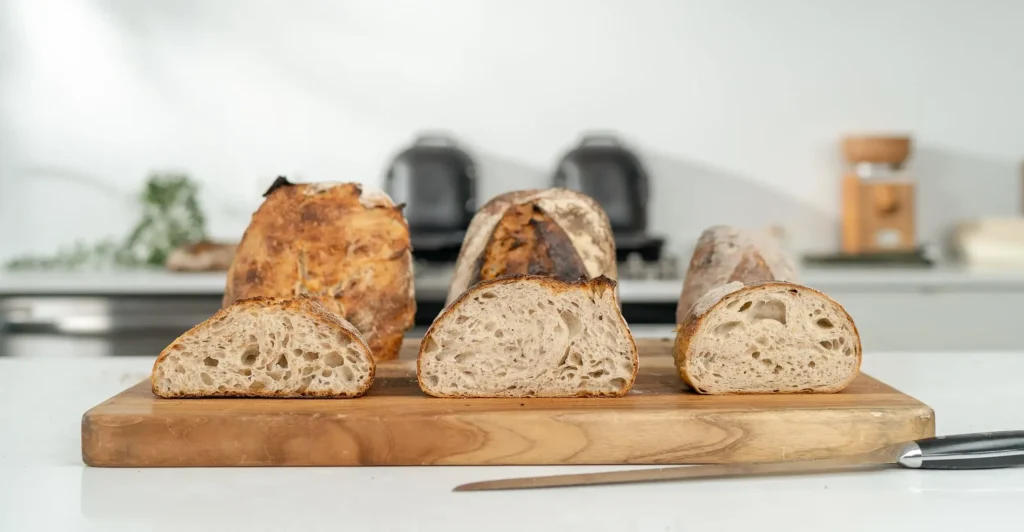
6 Easy Ways To Tell If Your Sourdough Is Under Fermented or Not
Baking sourdough is like an age-old art that’s been handed down from one generation to another, catching the interest of both beginners and seasoned bakers. Getting that ideal sourdough bread involves a careful mix of ingredients, time, and fermentation.
One common challenge for sourdough bakers is figuring out if their dough has fermented enough.
In this blog post, we’ll walk you through the signs of under-fermentation in sourdough, helping you achieve the perfect loaf every time. We’ll also share tips on how to fix under-fermented sourdough.
Table of Contents
ToggleFactors That Can Lead to Under-Fermentation in Sourdough
Under-fermentation in sourdough is a common issue that can make your bread taste, feel, and rise not as good as it could be. There are a few things that can cause this, stopping your sourdough from turning out the way you want it to.
Here’s a comprehensive list of factors to watch out for:
- Not Feeding Your Starter Enough: If your starter is hungry, it won’t have the right yeast and bacteria for good fermentation. Feed it regularly to keep it happy.
- It’s Too Cold Around: Fermentation loves warmth. Cold places slow the yeast and bacteria down, making your dough ferment too little.
- Not Enough Time for Fermentation: Rushing the process doesn’t give the microbes the time they need to do their thing. Letting it ferment longer usually gives better results.
- Starter Quality Isn’t Consistent: Your sourdough starter’s health matters for fermentation. If it’s not consistent, your dough might not ferment evenly.
- Flour and Water Need the Right Balance: Make sure you get the right mix of flour and water. Too little water can leave you with dry and under-fermented dough.
- Don’t Go Crazy with Salt: Salt is cool for flavor and controlling fermentation, but too much can slow down the microbes, making your dough under-fermented.
- Say No to Bleached or Super Processed Flours: Picking heavily processed or bleached flours might lack the good stuff needed for a strong fermentation.
- Knead and Mix Like a Pro: Good kneading or mixing spreads the yeast and bacteria evenly. If you skimp on this, your fermentation might be all over the place.
- Room Temperature Should Stay Chill: Temperature changes can mess up fermentation. Keep it warm for the best results.
- Not Too Acidic, Please: While some acidity is good, too much can mess with the yeast, giving you under-fermented dough.

Six Easy Ways To Tell If Your Sourdough Is Under Fermented
Under-fermentation can lead to various issues, affecting both the flavor and texture of your sourdough. To help you master the fermentation process, here are six easy ways to tell if your sourdough is under-fermented or not.
1. Lack of Rise
One of the most apparent signs of under-fermentation is a lack of rise in your sourdough. After the bulk fermentation stage, the dough should double or even triple in size.
If you notice that your dough hasn’t expanded as expected, it may indicate that the yeast and bacteria haven’t had enough time to produce sufficient gases. This results in a dense, heavy loaf with a tight crumb structure.
2. Sourness Level
While sourdough is known for its tangy flavor, the intensity of sourness can provide valuable clues about the fermentation process. If your sourdough lacks the desired tang or if the sourness is overpowering, it could be a sign of under-fermentation.
During the fermentation period, lactic acid bacteria produce acids that contribute to the sour flavor. Inadequate fermentation time means fewer acids, leading to a milder taste.
3. Uneven Crumb
The crumb, or the interior texture of the bread, can reveal a lot about the fermentation process. Under-fermented sourdough often exhibits an uneven crumb structure with irregularly sized and spaced air pockets.
Proper fermentation allows for uniform gas distribution throughout the dough, resulting in a well-structured crumb. If you observe large holes alongside smaller, uneven ones, it’s a clear indication that the fermentation process was not optimal.
4. Wet Gummy Crumb
Under-fermented sourdough tends to have a wet and gummy crumb texture. This occurs when the dough hasn’t had sufficient time for the starches to break down into sugars, and for the yeast to produce enough carbon dioxide.
As a result, the dough lacks structure, and the excess moisture creates a gummy consistency. When you cut into the loaf, an under-fermented sourdough might stick to the knife and feel overly moist instead of showcasing a well-developed crumb.
5. Poor Oven Spring
Oven spring refers to the final rise a loaf experiences during the first few minutes of baking. A well-fermented sourdough dough will have the strength to expand and rise beautifully in the oven.
On the contrary, under-fermented dough lacks the necessary gas production and structure, resulting in poor oven spring. If your bread appears flat and fails to achieve the desired volume during baking, it’s a strong indicator that the fermentation process is insufficient.
6. Sourdough Loaf Is Small and Heavy
A clear visual cue for under-fermentation is a small and heavy sourdough loaf. When the dough hasn’t undergone proper fermentation, it lacks the aeration necessary for a light and airy texture.
The loaf may feel dense and have a compact structure, making it less enjoyable both in terms of taste and mouthfeel. Achieving the right balance of fermentation is crucial to producing a sourdough loaf that is well-risen, flavorful, and has an appealing texture.

How To Fix Under-Fermented Sourdough
Realizing that your sourdough is under-fermented doesn’t mean the end of your baking journey. Fortunately, there are several effective ways to salvage and enhance the fermentation process to ensure a better outcome.
Here’s a guide on how to fix under-fermented sourdough:
1. Adjust Fermentation Time
The first and most straightforward solution is to extend the fermentation time. Give your sourdough more time to allow the yeast and bacteria to work their magic.
If you initially aimed for a shorter fermentation period, consider adding extra hours to ensure the dough undergoes the necessary fermentation stages. Keep in mind that the ideal fermentation time may vary based on factors such as room temperature and the specific sourdough recipe.
2. Modify Room Temperature Conditions
Temperature plays a crucial role in the fermentation process. If your kitchen is cooler than the recommended temperature range for sourdough fermentation, consider relocating the dough to a warmer spot.
You can place the bowl near a warm appliance, use a proofing box, or cover it with a warm towel. Conversely, if the environment is too warm, find a cooler area to slow down the fermentation process and allow for a more controlled rise.
3. Refresh Your Sourdough Starter
Sometimes, under-fermentation can be traced back to an inactive or weakened sourdough starter. Revitalize your starter by discarding a portion of it and feeding it with equal parts flour and water.
Repeat this process until the starter becomes more vigorous. A healthy and active starter ensures a robust fermentation process in your sourdough.
4. Use Warmer Water
The temperature of the water you use in your dough can impact fermentation. Using slightly warmer water can kickstart the activity of yeast and bacteria, promoting a more efficient fermentation process.
Be cautious not to use water that is too hot, as it may harm the microorganisms.
5. Experiment with Autolyse
Autolyse is a technique that involves allowing the flour and water to hydrate before adding the sourdough starter and salt. This method can enhance gluten development and improve fermentation.
Try incorporating autolyse into your sourdough process, adjusting the duration based on your preferences and the characteristics of your flour.
6. Knead and Fold the Dough
If you notice under-fermentation during the bulk fermentation stage, give your dough a few extra rounds of gentle kneading and folding. This helps redistribute yeast and bacteria, promoting more even fermentation.
Be gentle to avoid degassing the dough excessively, maintaining the desired structure.
7. Consider Adding a Pre-ferment
If you consistently face under-fermentation issues, consider incorporating a pre-ferment into your sourdough recipe. A pre-ferment, such as a poolish or a levain, allows for an initial fermentation stage before mixing the final dough.
This method can enhance flavor and jumpstart the fermentation process.

What Is The Difference Between Under Fermented Sourdough And Under Proofed Sourdough?
Understanding the difference between under-fermented and under-proofed sourdough is crucial for mastering the art of sourdough baking. While both issues can lead to less-than-ideal loaves, they stem from different stages of the fermentation process.
Let’s delve into the key differences:
Under Fermented Sourdough
Under-fermentation occurs when the dough hasn’t undergone sufficient fermentation time. This phase is critical for the yeast and bacteria to metabolize sugars, producing carbon dioxide and alcohol, which contribute to the rise and flavor of the sourdough.
Signs of under-fermentation include a lack of rise in the dough, a dense and heavy texture, and a diminished tangy flavor.
Causes of Under Fermentation:
- Insufficient Time: Not allowing the dough to ferment for an adequate duration.
- Low Room Temperature: Cooler environments slow down fermentation.
- Inactive Sourdough Starter: A weak or inactive starter may not provide enough yeast and bacteria for proper fermentation.
Fixing Under Fermented Sourdough:
- Extend Fermentation Time: Give the dough more time to ferment.
- Adjust Temperature: Provide a warmer environment for fermentation.
- Revitalize Starter: Ensure the sourdough starter is active and healthy.
Under Proofed Sourdough:
Under-proofing refers to insufficient time given to the shaped dough to undergo its final rise before baking. This stage is crucial for the dough to expand and develop its structure.
Signs of under-proofing include a dense crumb, limited oven spring, and a less-than-ideal final volume.
Causes of Under Proofing:
- Rushing the Process: Not allowing enough time for the shaped dough to rise.
- Inadequate Warmth: Cooler temperatures during the proofing stage hinder yeast activity.
- Underestimated Dough Size: Shaping the dough too tightly or using insufficient dough.
Fixing Under Proofed Sourdough:
- Extend Proofing Time: Allow the shaped dough to rise for a longer period.
- Optimal Temperature: Ensure the proofing environment is warm.
- Proper Shaping: Shape the dough with care, allowing it room to expand.
Key Differences:
- Timing: Under-fermentation occurs during the bulk fermentation stage before shaping, while under-proofing happens after shaping during the final rise.
- Characteristics: Under-fermented dough is characterized by a lack of rise and a heavy texture, while under-proofed dough results in a dense crumb and limited oven spring.
- Fixing Methods: Fixing under-fermented dough involves extending fermentation time, adjusting temperature, or revitalizing the starter. Under-proofed dough can be fixed by extending proofing time, ensuring optimal temperature, and shaping the dough appropriately.

How To Use Under-Fermented Sourdough Bread
While under-fermented sourdough may not have the ideal rise and flavor, it doesn’t mean you have to discard it. There are creative and delicious ways to repurpose under-fermented sourdough bread.
Here are some suggestions on how to make the most of your less-than-perfect loaf:
- 1. Toasting and Grilling: Transform your under-fermented sourdough by toasting or grilling it. The heat boosts the texture and flavor, making the bread nice and crunchy. Add butter, avocado, or your favorite spread for extra yum.
- 2. French Toast: Make a fancy breakfast by turning your not-so-perfect sourdough into French toast. Soak slices in a mix of eggs, milk, and cinnamon, then fry them up. Top with maple syrup, fresh fruit, or a sprinkle of powdered sugar for a tasty twist.
- 3. Croutons: Dice the under-fermented sourdough into small cubes, toss them with olive oil, herbs, and spices, and bake until golden brown. These homemade croutons can jazz up your salads or soups, giving them a crispy and tasty kick.
- 4. Bread Pudding: Let your under-fermented sourdough shine in a comforting bread pudding. Tear the bread into chunks, mix with a custard base, and bake until it sets. Throw in raisins, nuts, or chocolate chips for an extra indulgent treat.
- 5. Panzanella Salad: Mix chunks of under-fermented sourdough with fresh tomatoes, cucumbers, and herbs for a tasty Panzanella salad. The bread soaks up the flavors of the veggies and dressing, creating a refreshing and satisfying dish.
- 6. Breadcrumbs: Turn the under-fermented sourdough into breadcrumbs. Use a food processor to make fine or coarse crumbs, depending on what you like. Keep them in the freezer for later use in meatballs, coatings, or as a topping for casseroles.
Conclusion
In conclusion, mastering the art of sourdough requires a keen understanding of fermentation. By recognizing the signs of under-fermentation and employing simple detection methods, you can elevate your sourdough baking experience and enjoy delicious, well-risen loaves.
Lindsey Mackenzie
About me
Hi there! I’m Lindsey Mackenzie, the founder of Bake Smartly. Baking has been my passion since childhood, growing up in my father’s bakery. With Bake Smartly, I’m excited to share my love for all things sweet and savory. Join me on this delicious journey as we whip up scrumptious treats and sprinkle joy into every bite!






